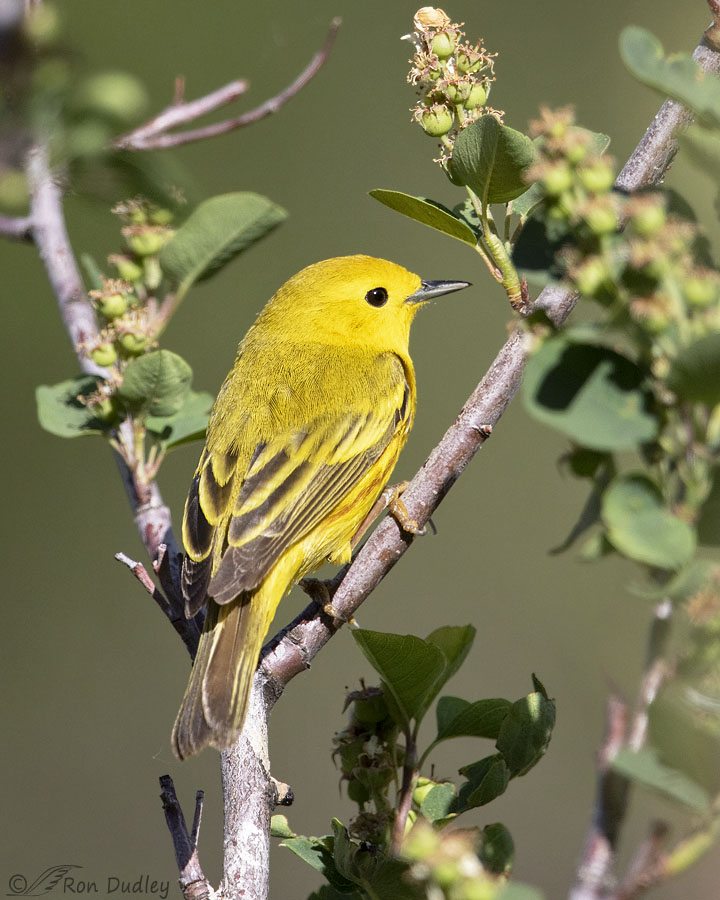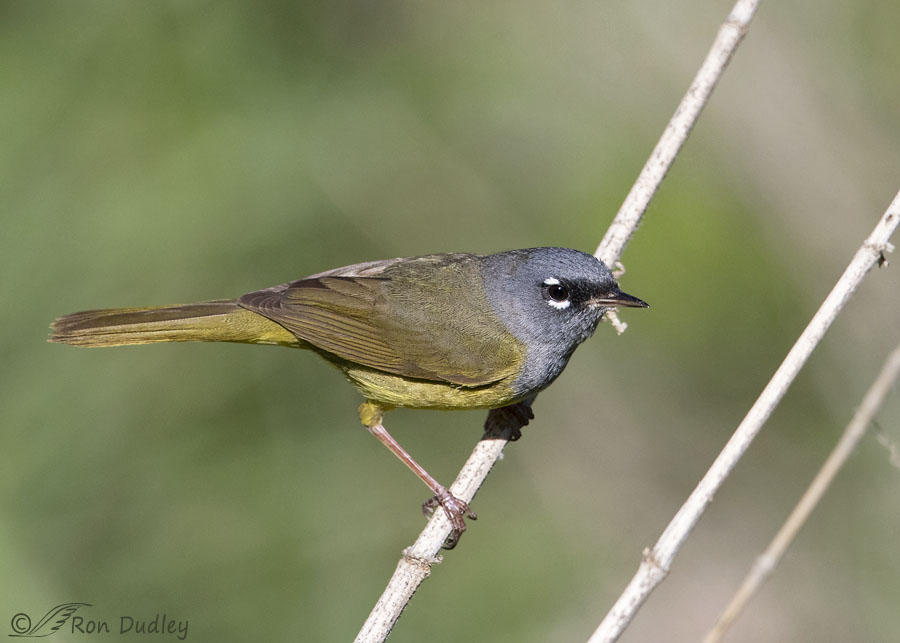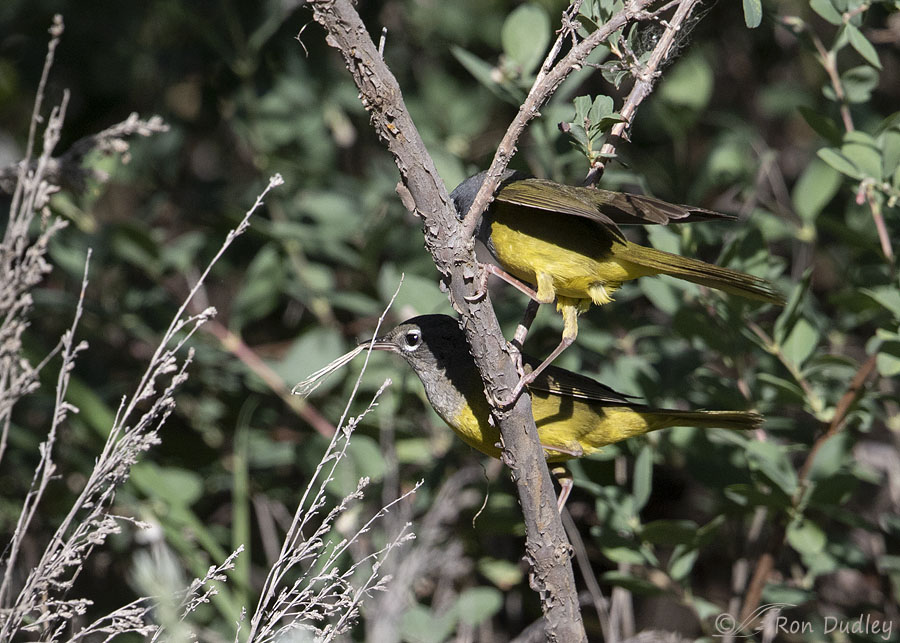I was particularly excited about the MacGillivray’s Warblers, a bird Cornell’s Birds of the World calls “a highly sought after trophy species by birdwatchers.”

1/3200, f/5.6, ISO 800, Canon 7D Mark II, Canon EF 500mm f/4L IS II USM + EF 1.4 III Extender, not baited, set up or called in
But I had at least some success with Yellow Warblers too. This is a complete grab shot. I’d been photographing other birds much further away when this guy unexpectedly flew in close to me and posed for about 3 seconds. The branches and leaves were so thick I was extremely lucky to get a few unobstructed photos.
A bit more of a head turn would have been nice and I’m not particularly fond of the out of focus vegetation in the foreground on the right but otherwise I like the photo quite well.
But the biggest excitement of the morning was provided by nesting MacGillivray’s Warblers.

1/4000, f/6.3, ISO 800, Canon 7D Mark II, Canon EF 500mm f/4L IS II USM + EF 1.4 III Extender, not baited, set up or called in
There were at least three of them in the area – this one is a male, distinguished from the similar female by his black lores and darker gray head. Both sexes have bright white eye crescents, 1 above and below each eye. This was the only time one of them came in close enough and out in the open enough for decent photos.
They were among the toughest subjects I’ve ever tried to photograph. MacGillivray’s Warbler is often referred to as a “shy skulker, making it difficult to detect on migration and on the breeding grounds” and that was certainly my experience with them yesterday. Usually I only got brief, far away glimpses of them as they darted from bush to bush and a House Wren that was upset by their presence certainly didn’t help matters. The highly aggressive wren harassed and chased the warblers almost constantly.

Their nest was far away and completely hidden but I did get a few documentary shots of the female with nesting material in her bill. In this species the female is primarily responsible for nest building but as we can see in this photo her mate was intensely interested in the process.
Little is known about the breeding biology of MacGillivray’s Warblers. A thorough study is yet to be done on their mating displays, nesting success, long-term reproductive success, natal dispersal, philopatry, predators throughout the annual cycle, mortality and longevity.
I have hopes of photographing this pair during much of this nesting cycle so who knows what behaviors I may be able to document.
I look forward to the opportunity if things work out.
Ron


I don’t know anything about the breeding biology of MacGillvray’s Warblers either but I do know they raise Brown-headed Cowbirds. I have a photo of one feeding a cowbird about twice it’s size!
Marya, brood parasitism from cowbirds is thought to be a significant detriment to MacGillivray’s Warblers. This from Cornell’s Birds of the World about the effect of brood parasitism from cowbirds on this species:
“Impact of brood parasitism may be greater than previously thought. Rasmussen and Sealy’s (2006) summary of the literature showed that only cowbird young were fed by parasitized pairs during the fledgling stage. Results suggest that host young may die early after fledging due to competition with cowbirds. Reproductive costs of competition may increase beyond the nestling stage, further reducing reproductive output.
Again just WOW!! I KNOW how fast three seconds pass so to get the “grab shot” is pretty darn spectacular! And the MacGillivray’s Warbler, not to be ridiculously redundant again, but WOW!
Thank you, Laura.
Great find!
Thanks, Jane.
Lucky you. I rarely see a Yellow Warbler here. Maybe just passing through. Beautiful photos.
Thank you, Jean.
Thank you for such joyful photographs today. I definitely needed the pop of sunshine and the image of the pair of MacGillivray’s Warblers preparing for new life.
Thank you, Marty. I’m glad you enjoyed them.
Glad you’re out there to get photos of this hard to find bird.
I’ve seen the Yellow Warbler, and been out with birders who recognized the MacGillivray’s song, so I will probably have to either learn the song or get really, really, really lucky and see one. Either one is long shot.
Since no one has asked I guess I will: It that something hanging from the branch or from the MacGillivray’s Warbler? I’m guessing branch.
Lyle, if you’re talking about the first photo it’s something hanging off the “branch” behind the bird.
In the second photo it’s nesting material in the female’s bill.
Both are truly beautiful birds. I suspect that the yellow warbler at least was often the subject of different trophy hunters in days gone by. It is too much to hope that we allowed those brilliant yellow feathers to remain on the bird.
Reading Dan’s comment my heart aches that the Macgillivrays Warblers numbers have declined so precipitiously. Despite the fact that little is known about them I suspect that we have had a great deal to do with that decline. Shy and secretive birds/animals tend to do much better when we leave their habitat alone.
Dan’s comment really surprised me, EC. I had no idea.
When I first started teaching Ornithology at the University of Oregon (1973) I had a list of birds that I expected students to know by sight or sound at the end of the course because they were so common that we would see or hear them almost every day on our morning trips. MacGillivray’s Warbler was on that list. It seemed as numerous as any woodland warbler except for Orange-crowned. By the time I retired 35 years later, we were lucky if we saw or one even once in the entire summer. They are still here, but far more scarce.
Wow, that’s a dramatic decline, Dan. I had no idea they were ever that common anywhere.
Oh Dan, that is a dramatic and heart-breaking decline.
Fantastic find and photo. I will have to keep an eye out while wandering.
Thanks, April. Finding them is the first part of the problem – next you have to get extremely lucky to get anything very good.
That is a warbler I’ve never even heard of…and two great catches! The male/female difference is pretty subtle…hope you can manage follow-up photos of these two…but I do know how those ‘hopes’ can sometimes go. Very nice yellow warbler !
Very nice yellow warbler !
“hope you can manage follow-up photos of these two…but I do know how those ‘hopes’ can sometimes go”
Kathy, I visited these warblers again this morning but it was extremely tough shooting. Haven’t looked at my photos yet but pretty sure I didn’t get anything very good.
Subtly pretty bird with GREAT camouflage……. Map says “maybe” here…. Even the yellow warblers can be illusive unless, of course, they are collecting spider webs at the corner of the picture windows…. Glad you were able to capture them and, with luck will be able to follow them!
Even the yellow warblers can be illusive unless, of course, they are collecting spider webs at the corner of the picture windows…. Glad you were able to capture them and, with luck will be able to follow them! 
Ha, with this species I think “maybe” found is the rule rather than the exception, even within their known range.
Like the term “Grab Shot” – have never known it, but understand it and often have them. Was concentrating on something else just a few days ago and a beautiful Summer Tanager landed on a branch right next to me. Your Yellow Warbler is really good. Have never seen nor heard of McGillivray’s Warblers, but very interesting looking birds. Good find.
Thanks, Everett. Summer Tanager would be a GREAT find for me.